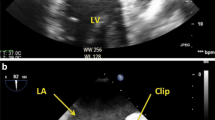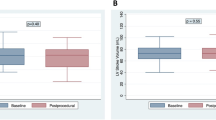Abstract
Background
Percutaneous left atrial appendage (LAA) closure can be an alternative to coumadin treatment in patients with atrial fibrillation (AF) at high risk for thromboembolic events and/or bleeding complications. We report the initial experience with this new technique.
Methods
Patients were eligible if they had AF with a high stroke risk (CHADS2 score >1), and/or contraindication for coumadin therapy. The procedure was performed under general anaesthesia, using biplane fluoroscopy and (3D) transoesophageal echocardiography (TEE) guidance. Patients were discharged on coumadin until a TEE was repeated at 45 days after closure to evaluate LAA occlusion. If LAA occlusion was achieved, oral anticoagulation was discontinued and aspirin started.
Results
Percutaneous LAA closure was performed in 10 patients (50% male, age 61.6 ± 9.6 years). The median CHADS2 score was 3 (range 2–4), median CHA2DS2-VASc score 3.5 (range 2–6) and HAS-BLED score 1.5 (range 1–4). Nine patients had a history of stroke and 2 patients had a history of major bleeding while on coumadin. Concomitant pulmonary vein isolation was performed in 9 patients. The device was successfully placed in all patients within a median of 56 min (38–137 min). Asymptomatic catheter thrombus occurred in one patient. At 45-day follow-up, no thromboembolic events occurred, TEE showed minimal residual flow in the LAA in three patients. In one patient the LAA device was dislocated, requiring successful percutaneous retrieval.
Conclusion
Device closure of the LAA may provide an alternative strategy to chronic coumadin therapy in patients with AF and high risk of stroke and/or bleeding complications using coumadin.

Similar content being viewed by others
References
Miyasaka Y, Barnes ME, Gersh BJ, et al. Secular trends in incidence of atrial fibrillation in Olmsted County, Minnesota, 1980 to 2000, and implications on the projections for future prevalence. Circulation. 2006;114:119–25.
Psaty BM, Manolio TA, Kuller LH, et al. Incidence of and risk factors for atrial fibrillation in older adults. Circulation. 1997;96:2455–61.
Lloyd-Jones DM, Wang TJ, Leip EP, et al. Lifetime risk for development of atrial fibrillation: the Framingham Heart Study. Circulation. 2004;110:1042–6.
Blackshear JL, Odell JA. Appendage obliteration to reduce stroke in cardiac surgical patients with atrial fibrillation. Ann Thorac Surg. 1996;61:755–9.
Goldman ME, Pearce LA, Hart RG, et al. Pathophysiologic correlates of thromboembolism in nonvalvular atrial fibrillation: I. Reduced flow velocity in the left atrial appendage (The Stroke Prevention in Atrial Fibrillation [SPAF-III] study). J Am Soc Echocardiogr. 1999;12:1080–7.
Garcia DA, Hylek E. Reducing the risk for stroke in patients who have atrial fibrillation. Cardiol Clin. 2008;26:267–75.
Lin HJ, Wolf PA, Kelly-Hayes M, et al. Stroke severity in atrial fibrillation. The framingham study. Stroke. 1996;27:1760–4.
Wolf PA, Abbott RD, Kannel WB. Atrial fibrillation as an independent risk factor for stroke: the Framingham Study. Stroke. 1991;22:983–8.
Connolly SJ, Pogue J, Eikelboom J, et al. Benefit of oral anticoagulant over antiplatelet therapy in atrial fibrillation depends on the quality of international normalized ratio control achieved by centers and countries as measured by time in therapeutic range. Circulation. 2008;118:2029–37.
Gage BF, Boechler M, Doggette AL, et al. Adverse outcomes and predictors of underuse of antithrombotic therapy in medicare beneficiaries with chronic atrial fibrillation. Stroke. 2000;31:822–7.
Hylek EM, Evans-Molina C, Shea C, Henault LE, Regan S. Major hemorrhage and tolerability of warfarin in the first year of therapy among elderly patients with atrial fibrillation. Circulation. 2007;115:2689–96.
Sudlow M, Thomson R, Thwaites B, Rodgers H, Kenny RA. Prevalence of atrial fibrillation and eligibility for anticoagulants in the community. Lancet. 1998;352:1167–71.
Camm AJ, Kirchhof P, Lip GY, et al. Guidelines for the management of atrial fibrillation: the task force for the management of atrial fibrillation of the european society of cardiology (ESC). Europace. 2010;12:1360–420.
Boersma LV, Wijffels MC, Oral H, Wever EF, Morady F. Pulmonary vein isolation by duty-cycled bipolar and unipolar radiofrequency energy with a multielectrode ablation catheter. Heart Rhythm. 2008;5:1635–42.
Bungard TJ, Ghali WA, Teo KK, McAlister FA, Tsuyuki RT. Why do patients with atrial fibrillation not receive warfarin? Arch Intern Med. 2000;160:41–6.
Nieuwlaat R, Olsson SB, Lip GY, et al. Guideline-adherent antithrombotic treatment is associated with improved outcomes compared with undertreatment in high-risk patients with atrial fibrillation. The Euro Heart Survey on Atrial Fibrillation. Am Heart J. 2007;153:1006–12.
Parker CS, Chen Z, Price M, et al. Adherence to warfarin assessed by electronic pill caps, clinician assessment, and patient reports: results from the IN-RANGE study. J Gen Intern Med. 2007;22:1254–9.
Sick PB, Schuler G, Hauptmann KE, et al. Initial worldwide experience with the WATCHMAN left atrial appendage system for stroke prevention in atrial fibrillation. J Am Coll Cardiol. 2007;49:1490–5.
Bayard YL, Omran H, Neuzil P, et al. PLAATO (Percutaneous Left Atrial Appendage Transcatheter Occlusion) for prevention of cardioembolic stroke in non-anticoagulation eligible atrial fibrillation patients: results from the European PLAATO study. EuroIntervention. 2010;6:220–6.
Fountain RB, Holmes DR, Chandrasekaran K, et al. The PROTECT AF (WATCHMAN Left Atrial Appendage System for Embolic PROTECTion in Patients with Atrial Fibrillation) trial. Am Heart J. 2006;151:956–61.
Holmes DR, Reddy VY, Turi ZG, et al. Percutaneous closure of the left atrial appendage versus warfarin therapy for prevention of stroke in patients with atrial fibrillation: a randomised non-inferiority trial. Lancet. 2009;374:534–42.
Reddy VY, Holmes D, Doshi SK, Neuzil P, Kar S. Safety of percutaneous left atrial appendage closure: results from the Watchman Left Atrial Appendage System for Embolic Protection in Patients with AF (PROTECT AF) clinical trial and the Continued Access Registry. Circulation. 2011;123:417–24.
Eikelboom JW, Wallentin L, Connolly SJ, et al. Risk of bleeding with 2 doses of dabigatran compared with warfarin in older and younger patients with atrial fibrillation: an analysis of the randomized evaluation of long-term anticoagulant therapy (RE-LY) trial. Circulation. 2011;123:2363–72.
Wallentin L, Yusuf S, Ezekowitz MD, et al. Efficacy and safety of dabigatran compared with warfarin at different levels of international normalised ratio control for stroke prevention in atrial fibrillation: an analysis of the RE-LY trial. Lancet. 2010;376:975–83.
Calkins H, Reynolds MR, Spector P, et al. Treatment of atrial fibrillation with antiarrhythmic drugs or radiofrequency ablation: two systematic literature reviews and meta-analyses. Circ Arrhythm Electrophysiol. 2009;2:349–61.
Disclosure
The Cardiology Department receives proctoring fees for training/educational services
Author information
Authors and Affiliations
Corresponding author
Rights and permissions
About this article
Cite this article
Swaans, M.J., Post, M.C., Rensing, B.J.W.M. et al. Percutaneous left atrial appendage closure for stroke prevention in atrial fibrillation. Neth Heart J 20, 161–166 (2012). https://doi.org/10.1007/s12471-011-0236-8
Published:
Issue Date:
DOI: https://doi.org/10.1007/s12471-011-0236-8




